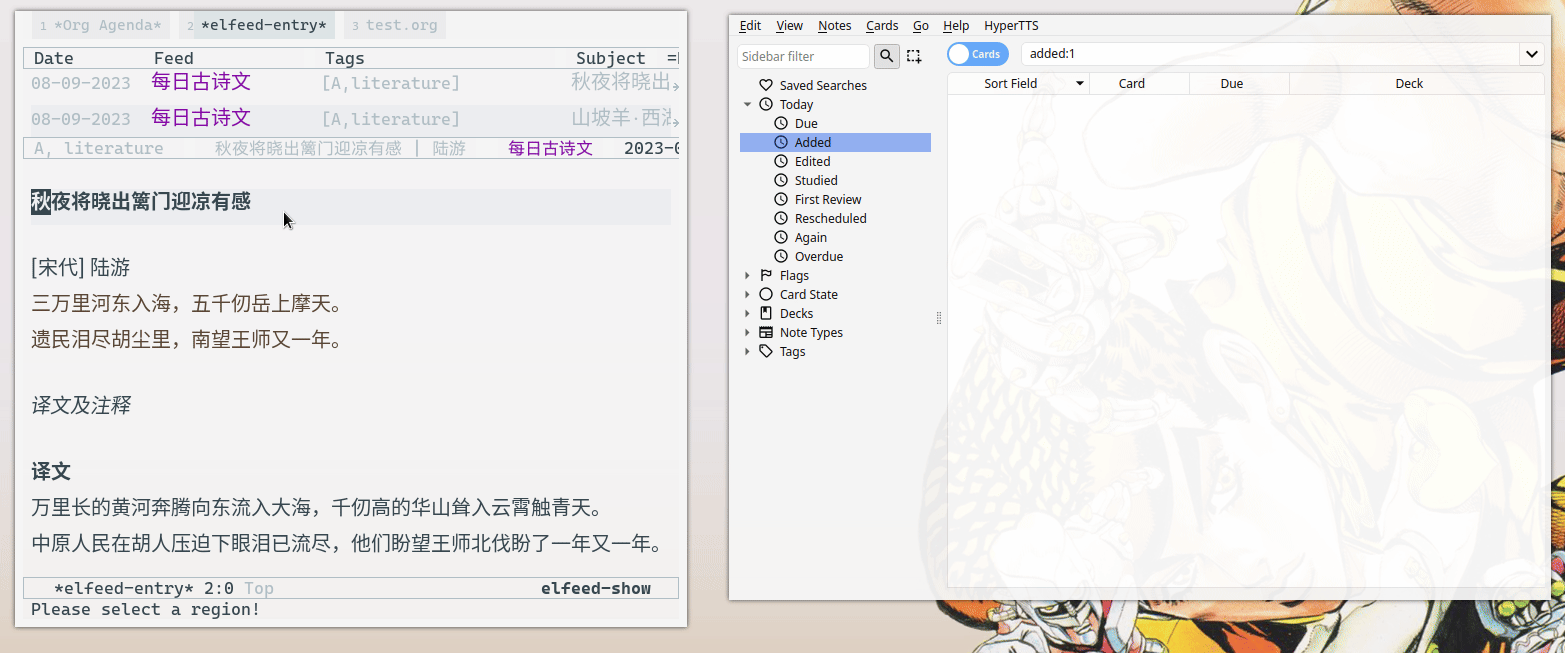Manage your Anki cards in Emacs 中文文档
Currently, the main packages for creating Anki cards are eyeinsky/org-anki and louietan/anki-editor.
anki-editor requires the use of dedicated header lines to mark the front and back sides of the cards. This first leads to the inability to quickly convert existing notes into cards, requiring manual conversion; secondly, the created cards can only be used by anki-editor and cannot be integrated into existing workflows, requiring a dedicated file to store them.
org-anki solves the above shortcomings well. It uses the headline as the front side and its content as the back side. But org-anki has its own drawbacks:
Taking examples/headings.org as an example, the time comparison for synchronizing and deleting all cards (422 in total) between org-anki and anki-helper is as follows:
| (benchmark 1 ‘(xxx-sync-all)) | (benchmark 1 ‘(xxx-delete-all)) | |
|---|---|---|
| org-anki | 123.855104s (35.423518s in 5 GCs) | 150.862886s (21.709634s in 8 GCs) |
| anki-helper | 0.410945s | 0.098308s |
Another issue with the org-anki is that it only applies to entries and does not provide an API for adding custom card-making functions. One advantage of having one card per entry is that it can save card information, such as card ID and whether it has been modified, making it convenient for future modifications. Another advantage is that different operations can be performed on different entries. However, some types of cards do not require this type of additional information, such as vocabulary cards. I only need to collect new words and then synchronize them with Anki, with very few modifications afterwards. Obviously, having one entry per word is quite wasteful.
The org-anki supports only two ways of filling fields: one is using the title line as the front side of the card and the content as the back side; the other is using subheadings to differentiate fields. The latter approach is similar to anki-editor. The problem here is that everyone has different habits and custom templates can be very diverse, so it is necessary to provide a set of flexible APIs to facilitate users in creating their own field filling functions.
The PR for image processing of org-anki has not been merged yet, and other multimedia content is also not supported.
anki-helper supports including images and audio file links in cards. These original files will be copied to the media folder of Anki.
For Cloze type cards, the usual practice is to use the format {{c1:xxx}}, but this will disrupt the original content and is not conducive to other operations. This is actually a kind of exclusivity.
Anki-helper uses the built-in rich text markup of org-mode as the indicator for cloze deletion. Assuming we have the following text:
*Canberra* was founded in *1913*.
will be converted into the following format while exporting to Anki:
{{c1::Canberra}} was founded in {{c2::1913}}.
Note: Following cloze deletions are not supported for now.
{{c1::Canberra}} was founded in {{c1::1913}}.
M-x package-vc-install RET https://github.com/Elilif/emacs-anki-helper RET
(add-to-list 'load-path "path-to-anki-helper")
(require 'anki-helper)anki-helper-cloze-use-emphasisIf the value is a symbol, such as
bold, then the following text*Canberra* was founded in *1913*.will be converted into the following format while exporting to Anki:
{{c1::Canberra}} was founded in {{c2::1913}}.Note: Following cloze deletions are not supported for now.
{{c1::Canberra}} was founded in {{c1::1913}}.anki-helper-default-note-typeDefault note type.
anki-helper-default-deckDefault deck name.
anki-helper-default-tagsDefault card tags.
anki-helper-default-matchDefault match used in
org-map-entriesfor sync all.anki-helper-skip-functionFunction used to skip entries.
anki-helper-inherit-tagsInherit tags, set to nil to turn off.
anki-helper-media-directoryDefault Anki media directory.
anki-helper-note-typesDefault fields for note types.
#+ANKI_DECK:#+ANKI_MATCH:#+ANKI_NOTE_TYPE:#+ANKI_TAGS:
The above keywords correspond to their respective global variables.
ANKI_NOTE_TYPEANKI_DECK
Each entry can have its own properties. The priority of the variables mentioned above is Properties > file-local variables > global variables.
A series of functions are provided by default to operate on cards of the entry type (more operations will be added later):
anki-helper-entry-syncTurn the entry under the cursor into a card, if it is already a card, ignore it.
anki-helper-entry-sync-allCreate cards for all entries in the current buffer that meet the condition, and ignore those that are already cards.
anki-helper-entry-deleteDelete the entry under the cursor if it is a card and meets the condition.
anki-helper-entry-delete-allDelete all cards in the current buffer that meet the specified condition.
anki-helper-entry-updateUpdate the entry under the cursor if it is a card and is modified.
anki-helper-entry-update-allUpdate all cards in the current buffer that are modified.
anki-helper provides several APIs:
anki-helper-requestanki-helper-create-noteanki-helper-create-notes
Please refer to the function documentation for specific usage details.
As an example, you can refer to the functions anki-helper-set-front-region and anki-helper-make-two-sided-card, which provide an interactive card-making method:
anki-helper-fields-get-alist sets two basic filed-filling functions:
anki-helper-fields-get-alistThis function is used for the “Bacis” note type of Anki, which use the raw value of the headline as the front and the content of the entry as the back.
anki-helper-fields-get-clozeThis functions is used for the “Cloze” note type of Anki, which use the content of the entry to fill the “Text” field and use the raw value of the headline to fill the “Back Extra” field.
See anki-helper-callback-alist for details.
